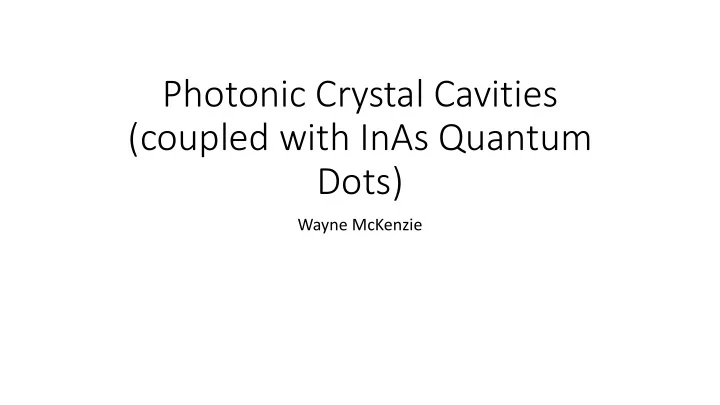

Photonic Crystal Cavities (coupled with InAs Quantum Dots) Wayne McKenzie
Introduction • Quantum Dots • Photonic Crystal Cavities • Current Research • Future Research
What are Quantum Dots? • Semi-conductor devices • Artificial atom’s • Resonance pumping results in s-shell population • Quasi-resonant (off resonant) results in p-shell population Quantum Memory Candidate 1us lifetime
What are Quantum Dots? • InP/InAs/GaAs dots emit 1um-1.55um photons (telecom wavelength) • We use AlInAs/InP dots grown through Molecular Beam Epitaxy
Why do we need photonic crystal cavities? • Quantum Dots • Incredibly useful for quantum experiments but, • Spontaneous emission (SE) from QD can occur in any direction • Emission efficiency is low • Introducing a cavity enhances the spontaneous emission of the QD through the Purcell effect. / F Q V P Q: Quality Factor, V: mode volume of cavity
Photonic Crystal with 2D periodic structure High index of refraction Low index of refraction (n=~1, air) (n = ~3)
• Measuring photons in the vertical direction while changing the lattice spacing (a) • When emission spectrum overlaps with PBG: • Vertical efficiency increases • SE can only occur vertically • Time of SE increases
Creation of a Cavity • A cavity can be created by removing three holes in the lattice, and shifting the holes on either side • This combination of removing/shifting has resulted in a Q ‘s of 4000 -45,000 while attempting to minimize V (to maximize Purcell effect) • Introducing this defect creates a cavity for wavelengths that fall within the PBG defined by the periodicity
• L3 Defect cavity • Q-factor • a = 370nm • M1: 7000 • Hole radius = 0.27a • M2: 4300 • Slab thickness = 280 nm • M3: 380 • M4: 2000 • M5: 1000
• Quantum dot needs to be cooled to 4K in a cryostat • The distance between the PC and lens at the entry of the cryostat can cause photons to spread • M1 mode has the highest Q-factor, but a far field measurement of the electric field (E y White line: 45 o and E x ) shows that most of the light would not couple with the lens collection angle
Current Research: Investigation of Biexcitons ~4 nm split ~1 nm Applying a magnetic field can reduce Fine Structure Splitting (FSS)
How to find Biexcitons?
Excitation (blue) and Emission Path (red) Cryostat Spectrometer Mirror Microscope slide Mirror’s for Vertical transition Variable Attenuator Lens Laser PBS Camera 780 nm pulsed laser
1 2 3 3 .8 7 1 2 3 4 .3 6 1 0 5 0 9 4 0 9 2 0 1 0 0 0 9 0 0 9 5 0 8 8 0 Intensity 8 6 0 Intensity 9 0 0 8 4 0 8 2 0 8 5 0 8 0 0 8 0 0 7 8 0 7 5 0 7 6 0 0 5 1 0 1 5 2 0 2 5 3 0 0 5 1 0 1 5 2 0 2 5 3 0 P o w e r P o w e r X 2 response 1 2 6 7 .5 7 9 4 0 1 2 5 0 .8 1 0 5 0 9 2 0 9 0 0 1 0 0 0 8 8 0 9 5 0 8 6 0 Intensity Intensity 8 4 0 9 0 0 8 2 0 8 5 0 8 0 0 7 8 0 8 0 0 7 6 0 7 5 0 0 5 1 0 1 5 2 0 2 5 3 0 7 4 0 0 5 1 0 1 5 2 0 2 5 3 0 P o w e r P o w e r
Future Work Energy GaAS (Coduction Band) - Wetting Layer - p-shell - s-shell Resonance s-shell + p-shell Wetting Layer + + GaAS (Valence Band)
Continuing Research • On resonance pumping scheme • Photoluminescence excitation (PLE) measurements • Vary the pump wavelength and take spectrum measurments • Graph Pump wavelength vs. spectrum to determine s-shell (resonance) or p- shell (quasi-resonant) behavior • Find additional QD’s that are better candidates for find biexcitons • This is limited due to the constraint of photons that are telecom wavelength
Questions??
Recommend
More recommend